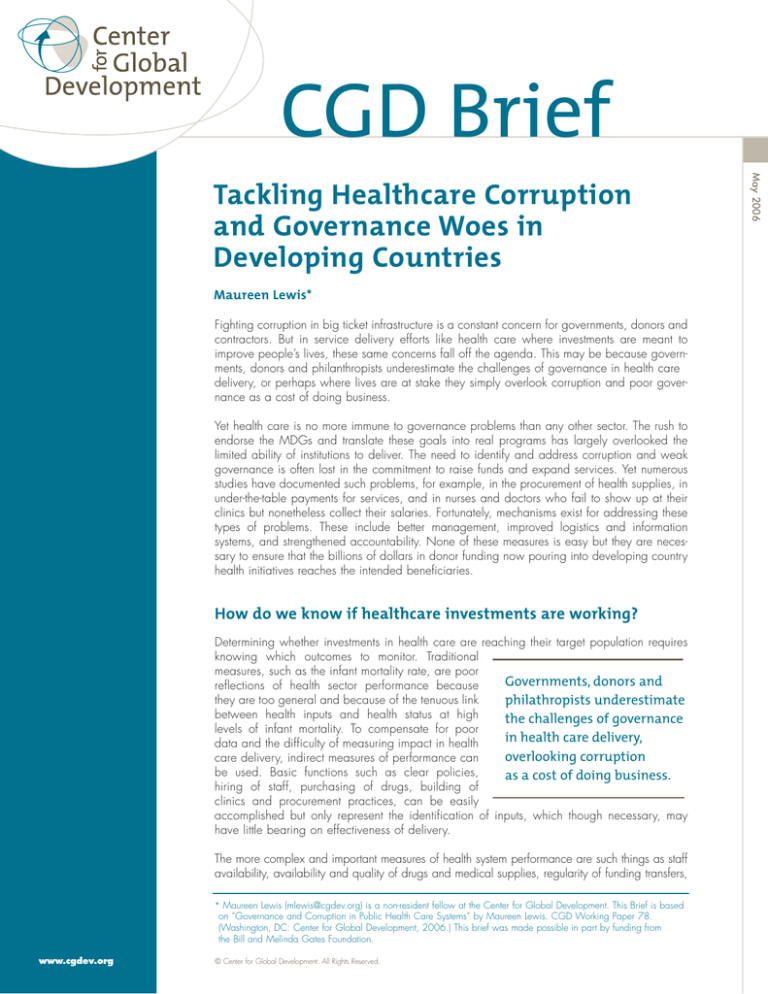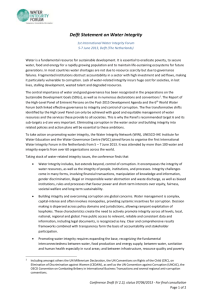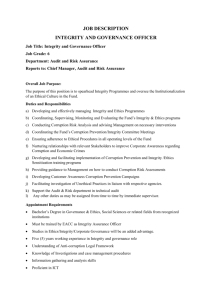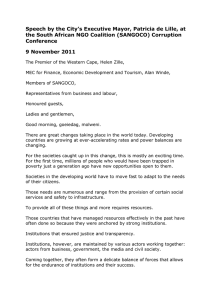
CGD Brief
Maureen Lewis*
Fighting corruption in big ticket infrastructure is a constant concern for governments, donors and
contractors. But in service delivery efforts like health care where investments are meant to
improve people’s lives, these same concerns fall off the agenda. This may be because governments, donors and philanthropists underestimate the challenges of governance in health care
delivery, or perhaps where lives are at stake they simply overlook corruption and poor governance as a cost of doing business.
Yet health care is no more immune to governance problems than any other sector. The rush to
endorse the MDGs and translate these goals into real programs has largely overlooked the
limited ability of institutions to deliver. The need to identify and address corruption and weak
governance is often lost in the commitment to raise funds and expand services. Yet numerous
studies have documented such problems, for example, in the procurement of health supplies, in
under-the-table payments for services, and in nurses and doctors who fail to show up at their
clinics but nonetheless collect their salaries. Fortunately, mechanisms exist for addressing these
types of problems. These include better management, improved logistics and information
systems, and strengthened accountability. None of these measures is easy but they are necessary to ensure that the billions of dollars in donor funding now pouring into developing country
health initiatives reaches the intended beneficiaries.
How do we know if healthcare investments are working?
Determining whether investments in health care are reaching their target population requires
knowing which outcomes to monitor. Traditional
measures, such as the infant mortality rate, are poor
Governments, donors and
reflections of health sector performance because
they are too general and because of the tenuous link
philathropists underestimate
between health inputs and health status at high
the challenges of governance
levels of infant mortality. To compensate for poor
in health care delivery,
data and the difficulty of measuring impact in health
overlooking corruption
care delivery, indirect measures of performance can
be used. Basic functions such as clear policies,
as a cost of doing business.
hiring of staff, purchasing of drugs, building of
clinics and procurement practices, can be easily
accomplished but only represent the identification of inputs, which though necessary, may
have little bearing on effectiveness of delivery.
The more complex and important measures of health system performance are such things as staff
availability, availability and quality of drugs and medical supplies, regularity of funding transfers,
* Maureen Lewis (mlewis@cgdev.org) is a non-resident fellow at the Center for Global Development. This Brief is based
on “Governance and Corruption in Public Health Care Systems” by Maureen Lewis. CGD Working Paper 78.
(Washington, DC: Center for Global Development, 2006.) This brief was made possible in part by funding from
the Bill and Melinda Gates Foundation.
www.cgdev.org
© Center for Global Development. All Rights Reserved.
May 2006
Tackling Healthcare Corruption
and Governance Woes in
Developing Countries
Tackling Healthcare Corruption and Governance Woes in Developing Countries
2
functioning equipment, and existence of patient records. These
factors, which can be readily observed, can tell us whether a
health system is meeting minimal efficiency and quality
standards. Utilization data and patient satisfaction offer
complementary metrics of health system effectiveness because
under-utilized public facilities or the dissatisfaction of target
groups often point to implementation problems. By monitoring
these measures, it is possible to determine how seriously
corruption and governance woes are affecting a health system.
What indicates shortcomings
in health service delivery?
Systems of poorly functioning health systems include:
MISMANAGEMENT AND INADEQUATE TRAINING
Core management problems include human resource management and supervision, basic subsystem operations (e.g.,
procurement, drug distribution, logistics) and input availability.
Mismanagement in such areas undermines service delivery. For
example, hospital efficiency suffered due to lack of management training in Turkey and the Dominican Republic, but similar
problems emerge at public clinics where clinical training
substitutes for management skills.
Indicators Capturing Poor Governance in
Health Service Delivery
Mismanagement
■
Leakage of drugs and supplies
■
Patients provide in-kind supplies and drugs
■
Irregular budget transfers
Absenteeism of Staff
Corruption
■
Mis-procurement and kickbacks
■
Irregularity in purchase of drugs and supplies
■
Petty theft
Informal payment from patients
Vague and poorly understood policies, uneven recordkeeping
and minimal use of such information contribute to poor
management. An assessment in Nigeria found a low level of
knowledge among health ministry staff regarding standard
procedures and regulations, and current budget allocations.
Moreover, current budgets and expenditures did not correspond. In Uganda staff records were inadequate as only 56
percent of facility staff existed in district records. In Honduras
2.4 percent of staff were “ghost” workers and 5 percent of staff
had unilaterally moved to other locations without the knowledge
of management. These kinds of problems stem from lack of
management skills, absence of information systems and
flawed oversight.
Drugs and supplies are among the most commonly “leaked”
products. Drugs in particular fetch a high price in the private
market. Virtually all qualitative studies that have probed this
issue emerge with the view that quality and drug availability
are virtually synonymous. Lack of drugs has been repeatedly
shown to discourage utilization of public facilities. In China
various studies indicate that on average about 30 percent of
public drug supplies are expired or counterfeit, attributed to
minimal public budgets, graft and no accountability. The
average leakage rate for drugs in rural public facilities in
Uganda was estimated at 73 percent , ranging from 40 to
94 percent.
In-kind supplies from patients entail bringing or purchasing
basic supplies (e.g., bed sheets, bandages or drugs), and in
some instances equipment. The concentration of private
health services adjacent to public hospitals and clinics in
many countries attests to the chronic shortages of basic inputs
and malfunctioning equipment.
In the Kyrgyz Republic in 2001, among hospitalized
patients 98 percent brought food, 73 percent linens, 80
percent had family members purchase drugs and 76 percent
supplied medical supplies. Similar patterns were reported
for Tajikistan. Patients paid for 50 percent of drugs in an
urban hospital in the Dominican Republic.
In Nigeria equipment inventory showed that 25 percent of
health facilities had about half of the minimum package of
equipment, while 40 percent had less than a quarter of
what was needed. In Ethiopia two separate surveys revealed
that only 21 percent of public hospitals had autoclaves (sterilizers) and 46 percent had functioning operating theaters,
both serious shortcomings given the spreading AIDS epidemic
and the high volume of patients.
Tracing non-wage funding between central government
and local providers using public expenditure tracking systems
(PETS) identifies a key problem in effective public management. In Ghana, Peru, and Uganda leakage is 70 percent
of total transfers; it is 40 percent in Tanzania. High leakage
means inadequate funding for non-salary spending, which
Figure 1. Absence Rates Among Health
Workers in Selected Countries
ABSENTEEISM
Health provider absenteeism is chronic in much of the developing world leading to closed public clinics, limited patient
access to services, lower quality, and, eventually, corruption.
But absenteeism occurs for various reasons, many of them
legitimate or necessary. For example, rural health workers
often need to travel to larger towns to receive their paycheck,
fetch supplies or drugs, and impassable roads or bad weather
delay them. All lead to absences but are necessitated by inadequate management or other shortcomings. In other cases
physicians or nurses simply don’t show up.
Recent measures of absenteeism in health clinics in developing countries report averages of around 50 percent, ranging
from a low of 19 percent in Papua New Guinea to a high of
75% recorded in one study in Bangladesh (Figure 1).
In Ethiopia, understaffing was attributed to late arrivals, long
breaks and a general disregard for the necessity of staffing
clinics. Absences are frequently motivated by responsibilities
at second jobs. Managerial reluctance to confront physicians
often inspires lower level workers to behave accordingly, leading to high absenteeism and low productivity at all levels.
Low or unpaid wages also force workers to seek additional
employment outside government. In Mozambique, focus
groups of health workers said they missed work or cut short
their hours to devote time to other economic activities. In
Kogi State, Nigeria, 42 percent of the staff had not been
paid their salaries for more than 6 months in the past year,
converting staff into virtual volunteers and eroding the credibility of the health system. Another study in Nigeria showed
that the greater the lag in paying salaries the more likely
health workers were to engage in pharmaceutical sales and
seek other employment in the private sector. Family survival
therefore plays a role in absenteeism and low productivity.
Absent health workers face few consequences due to the lack
of accountability for public servants. Without accountability,
abuses are more likely to proliferate and eventually undermine
the health care system.
CORRUPTION
The line between mismanagement and corruption is a fine
one, and varies by circumstance and setting. Corruption can
Uganda (2004)
Sources: Lewis 2006.
be defined as “use of public office for private gain”(Bardhan
1997). Country surveys of public officials, the business
community and the general public, and health provider
perception surveys gauge perceptions of corruption in public
service provision giving a sense of the kinds and frequency of
corruption in facilities as well as the likely perpetrators by profession. Both types of surveys capture corrupt practices, which
by their nature are not typically visible.
In corruption surveys interviewing public officials, business
executives and the general public in 23 countries, health
ranked in the top four most corrupt sectors in 10 countries:
Moldova, Slovakia, Tajikistan, Bangladesh, India, Sri Lanka,
Kazakhstan, Kyrgyz Republic, Madagascar and Morocco
(Figure 2). These countries also ranked prominently on the percent of the population perceiving high levels of overall corruption.
In Bosnia and Herzegovina, Bulgaria, Macedonia, Romania,
Croatia, and Montenegro 45-55 percent of respondents felt
that corruption among doctors was widespread. Albania and
Serbia showed much higher levels in the 61-71 percent
3
May 2006
requires patients to “contribute” via financial or in-kind
contributions. Poor recordkeeping in the sector has limited the
number of countries with data, in itself an indicator of serious
flaws that deserve attention.
Tackling Healthcare Corruption and Governance Woes in Developing Countries
4
Figure 2. Percent Perceiving Corruption in the Health Sector
Sources: Lewis 2006.
range. In Bolivia a local survey of patients considered the
Health Ministry and public hospitals less corrupt than customs
or police, but ranked health corruption 2.7 on a scale of 1-4,
noting the nepotism, clientelism and higher charges for the
unconnected as some key indicators of irregularity. Surveys
from South Asia suggest similar perceptions of the sector.
Corruption compromises public investments, and reflects a
lack of both accountability to and oversight by public officials
and citizen. Moreover, it entails waste in a highly constrained
resource environment.
Overpayment for supplies, ignoring competitive bidding practices and taking kickbacks are documented in Argentina,
Colombia and Venezuela, and in Ghana 18 percent of the
value of contracts is routinely required of public contracts.
Anecdotal evidence and focus group results suggest that these
are not isolated events, but they are perpetrated because of a
lack of both oversight and/or enforcement of rules.
Informal payments are payments to individual and institutional
providers outside official payment channels. This encompasses
cash ‘envelope’ payments to physicians, ‘contributions’ to
hospitals and in kind compensation to providers. They are
under-the-table payments to doctors, nurses and other public
medical staff for jumping the queue, receiving better or more
care, obtaining drugs, or just simply for any care at all (Figure 3).
Selling public positions and requiring bribes for promotion
builds a corruption spiral since the newly hired and promoted
must find the resources to ensure their continued employment
and advancement. In Latvia, Armenia and Georgia the “cost”
of public positions is well known among public officials and
the general public with the higher cost jobs in the most corrupt
enclaves of government. In Bosnia and Herzegovina, 75
percent of officials thought bribes were required for obtaining
positions and for promotion. In Ghana 25 percent of jobs
were allegedly bought in government hospitals, and in
Uganda 20 percent of municipal officials acknowledged that
the practice occurred in the health sector.
Informal payments create a parallel market for services within
public health care systems, and, like the informal sector are
typically illegal and unreported. Informal payments have
become a widespread phenomenon in much of the developing
world. For example, in Bolivia the incidence of informal
payments was significantly correlated with perceptions of
corruption in specific public hospitals and 40 percent of interviewed patients acknowledged making illicit payments for
care. In Costa Rica 85 percent of the medical staff indicated
that under-the-table payments to physicians were common,
valued at roughly 50 percent of a private sector consultation.
INFORMAL PAYMENTS
Of concern is the relative cost of informal payments to patients,
and numerous studies point out the heavy burden on the poor.
While outpatient fees are more common, inpatient costs can
exceed annual family income forcing the sale of assets or the
accumulation of debt in order to afford care.
So what can be done?
Strategies for improving
health care delivery
Actions are needed to improve government effectiveness,
reduce corruption and encourage accountability of public
providers. Some of the proven strategies for correction include
the following interventions.
IMPROVING MANAGEMENT
5
Adequate incentives for health professionals lie more
in the structure of the health care system and its financing than
in limited actions that
fix existing arrangements.
Fundamentally money needs Money needs to follow
to follow patients at least in patients to establish
terms of tying medical staff
proper incentives and
time to specific patients.
Payment methods are the increase productivity.
cornerstone of incentives for
productivity and performance.
May 2006
In South Asia patients typically must pay at arrival and individually for services, and in Georgia and Poland for each item,
from registering to paying bribes for changing bed sheets. Left
unchecked such practices lead to flaunting of rules and policies
and blatant corruption.
In the OECD physicians whose earnings are based
on salary rather than fee-for-service, bonus payments or
capitation showed lower productivity, lower levels of care
and higher wound rates from surgery.
Low wages represent one area of potential temptation for
corruption. Where earnings are low individuals have second
and third jobs, but they also perceive that low wages entitle
Figure 3. Proportion who make Informal Payments Among Users of Health Services,
Selected Countries
Sources: Lewis 2006.
Tackling Healthcare Corruption and Governance Woes in Developing Countries
6
them to demand contributions from patients. Civil service
reform may be required to address structural problems related
to postings, promotion and pay, but experimentation with
other payment arrangements remains a priority.
Drug procurement reform in Chile to blunt high costs, align
the mismatch between need and supply, and address
frequent stock outs entailed: (1) electronic bidding for pharmaceuticals; (2) allowing the drug purchasing agency to
only serve as the procurement agent for hospitals; (3)
informing pharmaceutical procurement agents they are
under scrutiny; and (4) removing the drug purchasing agent
monopoly. Together these actions raised performance and
lowered costs
In additional to basic skills, institutional incentives, particularly the ability to hire and fire staff, are far more powerful than
education or experience in raising the quality of care, so
incentives are needed to foster improvements in health care.
A nationwide database for matching staff and wage payments
to maintain up-to-date personnel records to eliminate abuses
such as paying “ghost” workers is key.
ADDRESSING ABSENTEEISM
Wage increases are commonly recommended, but the evidence on resulting performance does not support such policies,
at least not without additional efforts of the kind discussed here.
Experimentation in Tanzania suggests the importance of local
authority to hire and fire staff as a means of raising reliability
and quality of physician performance, suggesting that
accountability effectively used can have an impact on both
absenteeism and output.
Adequate management entails some form of staff oversight.
In Bolivia, frequent written evaluations of performance, and
means for rewarding and disciplining staff proved effective.
Informing staff of possible sanctions with absenteeism
reduced the practice in Venezuela, and in education, initial
surprise visits to schools in eight countries led to lower
teacher absenteeism in subsequent unannounced visits.
Together these suggest
that informing staff that
Evidence from Tanzania
their performance will
suggests accountability
be monitored and they
will be held accounteffectively used can
able can reduced
have an impact on both
absenteeism.
absenteeism and output.
In education, inspectors lowered absenteeism in some
cases, and this may apply in health care through abuses
reported in CIS countries suggest caution in adopting inspections. Inspectors were an effective tool of accountability and
had some effect in Ecuador, India and Indonesia, but no
effect at all in Peru and Uganda.
STEMMING CORRUPTION
A national, integrated, mutually reinforcing anti-corruption
strategy with strong political backing and a willingness to
take a position and follow through can provide the support
that sectoral reforms need. Poland is a case in point where
health was encompassed by a broader anti-corruption agenda
and illegal practices declined.
An experiment in Ethiopia showed that the potential for
getting caught offers a stronger disincentive for corrupt
behavior than higher wages, suggesting the importance of
oversight and enforcement.
A fundamental initiative is the establishment and enforcement
of clear procurement and contracting rules. In Argentina
when the health system transparency policy was introduced
the prices of procured supplies dropped sharply but rose
again once the policy was no longer enforced. In Colombia
price variations in purchases across public hospitals were systematically lower where the price lists negotiated and
endorsed by a local NGO were applied.
The frequency of health provider audits by the central
government and enforcement increased immunization
coverage, suggesting that local governments can benefit from
auditing, and auditing encourages more responsible public
services. In Madagascar, sanctions for misuse of funds led to
systematic following of financial procedures.
Community oversight in Bolivia, Madagascar, the Philippines,
Uganda improved local public performance. The centralized
hiring, promotion and deployment of public health workers in all
countries effectively neutralizes the role of local supervision. If the
consequences of absenteeism, taking of bribes and stealing of
drugs are beyond the authority of local boards or community
oversight bodies, abuses cannot be contained. Locally organized oversight has also shown promise based on experience in
Ceara, Brazil and in Bolivia.
ELIMINATING INFORMAL PAYMENTS
Controlling informal payments can be achieved
through establishing alternative sources of funding and
In Cambodia reorganization of hospital staffing combined
with a transparent official fee policy, clearly designated
exemptions, and retained fee revenue that supplemented physician salaries at levels comparable to those earned under informal arrangements led to more reliable pricing, stable revenue
and higher demand. Predictability and equity adjustments
improved access without compromising utilization or hospital
revenue, the latter a critical component of compensation given
salary levels.
Fee exemptions offers the potential for targeting resources at
those least able to afford health care. Existing programs are
uneven across income groups. Generally the absolute amount
the poor pay is lower than what the non-poor pay, but amounts
tend to be a significantly higher proportion of income for the
poor as compared to the better off.
Venezuela found a decline in theft and unjustified absences
with greater accountability within hospitals.
forum for informed local debate and action on public health
care delivery. Progress can be achieved on multiple fronts,
but good diagnosis, careful implementation and at least
minimal health care accountability are critical if health service
delivery is to be improved.
References
Bardhan, P. 1997. “Corruption and Development: A Review
of Issues.” Journal of Economic Literature 35(3) 1310-1346.
Kaufmann,D. and A. Kraay 2003. “Governance and Growth:
Causality which way?—Evidence for the World, in Brief.”
Washington, D.C.: World Bank.
Kaufman, D, A. Kraay and M. Maztruzzi. 2005. “Governance
Matters III: Governance Indicators for 1996-2002.”
Washington, D.C.: World Bank.
Maureen Lewis. “Governance and Corruption in Public
Health Care Systems” CGD Working Paper 78.
(Washington, DC: Center for Global Development, 2006).
RAISING ACCOUNTABILITY
Government contracting out services can often raise the
performance of publicly subsidized services, partly because
holding contractors accountable is far easier than doing so
with public workers. Experience in Haiti, Cambodia and
Central America suggest contracting out can work even in the
lowest income environments.
Consumer satisfaction surveys help build accountability
because it offers an independent assessment. Exit surveys,
mini-household surveys or focus groups to elicit responses help
gauge the strengths and weaknesses of public programs.
More information to citizens about resource flows from
central and local governments and clarity on the roles and
responsibilities of local authorities strenghthens accountability.
In education, Uganda used the local press and updates on central
government transfers attached to schoolhouse doors to inform
the community about the status of resource availability at the
local level, significantly raising the amount of transfers received
locally. These same techniques apply to health as well.
Citizen report cards equip citizens with information on
the strengths and shortcomings of public health services.
Press reports based on such assessments provide a public
Related CGD Work
Global health is one of the Center’s core areas of policy-based
research. Our work on global health concentrates on the
challenges and opportunities it presents to global development
and poverty reduction, including issues of human capital
formation, institutional development, corruption, and
accountability. For related CGD materials on this issue,
please refer to the following publications, which are available
online at www.cgdev.org.
Owen Barder. Making Markets for Vaccines. CGD Brief.
(Washington, DC: Center for Global Development, 2005.)
Ruth Levine and the What Works Working Group with
Molly Kinder. Millions Saved: Proven Successes in
Global Health. (Washington, DC: Center for Global
Development, 2004.)
Todd Moss and Michael Clemens. What’s Wrong
with the Millennium Development Goals? CGD Brief.
(Washington, DC: Center for Global Development, 2005).
Theodore H. Moran, Edward M. Graham and Magnus
Blomström, eds. Does Foreign Direct Investment Promote
Development? (Washington, DC: Center for Global
Development, 2005).
7
May 2006
better management. Raising official fees as a substitute for
under-the-table payments improved patient payment and utilization in two pilot programs in Kyrgyz Republic, and in
Cambodia where patients spending declined by 20 percent
and 50 percent for drugs and supplies, respectively.
The
Center for Global Development is an independent, non-partisan, non-profit think tank
dedicated to reducing global poverty and inequality through policy oriented research and active
engagement on development issues with the policy community and the public. A principal focus of
the Center’s work is the policies of the United States and other industrialized countries that affect
development prospects in poor countries. The Center’s
research assesses the impact on poor people
of globalization and of the policies of governments and multilateral institutions. In collaboration with civil
society groups, the Center seeks to identify
policy alternatives that will promote equitable growth
and participatory development in low-income and transitional economies. The Center works with other
institutions to improve
public understanding in industrialized countries of the economic, political,
and strategic benefits of promoting improved living standards and governance in developing countries.
1776 Massachusetts Ave., NW
Third Floor
Washington, D.C. 20036
www.cgdev.org
CGD Brief
Tackling Healthcare Corruption and Governance
Woes in Developing Countries
Maureen Lewis
May 2006





